12 Best Drag and Drop Website Builders for 2025
Building a professional website no longer requires a team of developers or extensive coding knowledge. Thanks to modern drag-and-drop technology, anyone from a SaaS founder to a freelance designer can create a stunning online presence. But with so many options available, choosing the right platform can feel overwhelming, leading to costly mistakes and wasted time.
This guide cuts through the noise to provide a detailed, hands-on comparison of the best drag and drop website builders available today. We move beyond generic feature lists to explore each platform's unique strengths, practical limitations, and ideal use cases. You'll learn which builder is best for launching a simple portfolio, scaling a complex online store, or creating a high-fidelity prototype.
Our goal is to equip you with the specific insights needed to select the perfect tool that aligns with your goals, budget, and technical comfort level. Each review includes screenshots and direct links, helping you make an informed decision and ensuring your digital vision becomes a reality. We'll analyze everything from template quality and e-commerce capabilities to integrations and SEO performance, so you can choose confidently and get back to building your business.
1. Wix
Wix solidifies its place as one of the best drag and drop website builders by offering an unparalleled combination of creative freedom and user-friendly design. Its true drag-and-drop editor allows for pixel-perfect placement of any element anywhere on the page, a level of control not always found in grid-based editors. For those seeking maximum speed, Wix ADI (Artificial Design Intelligence) can generate a complete, functional website in minutes based on a few simple questions.
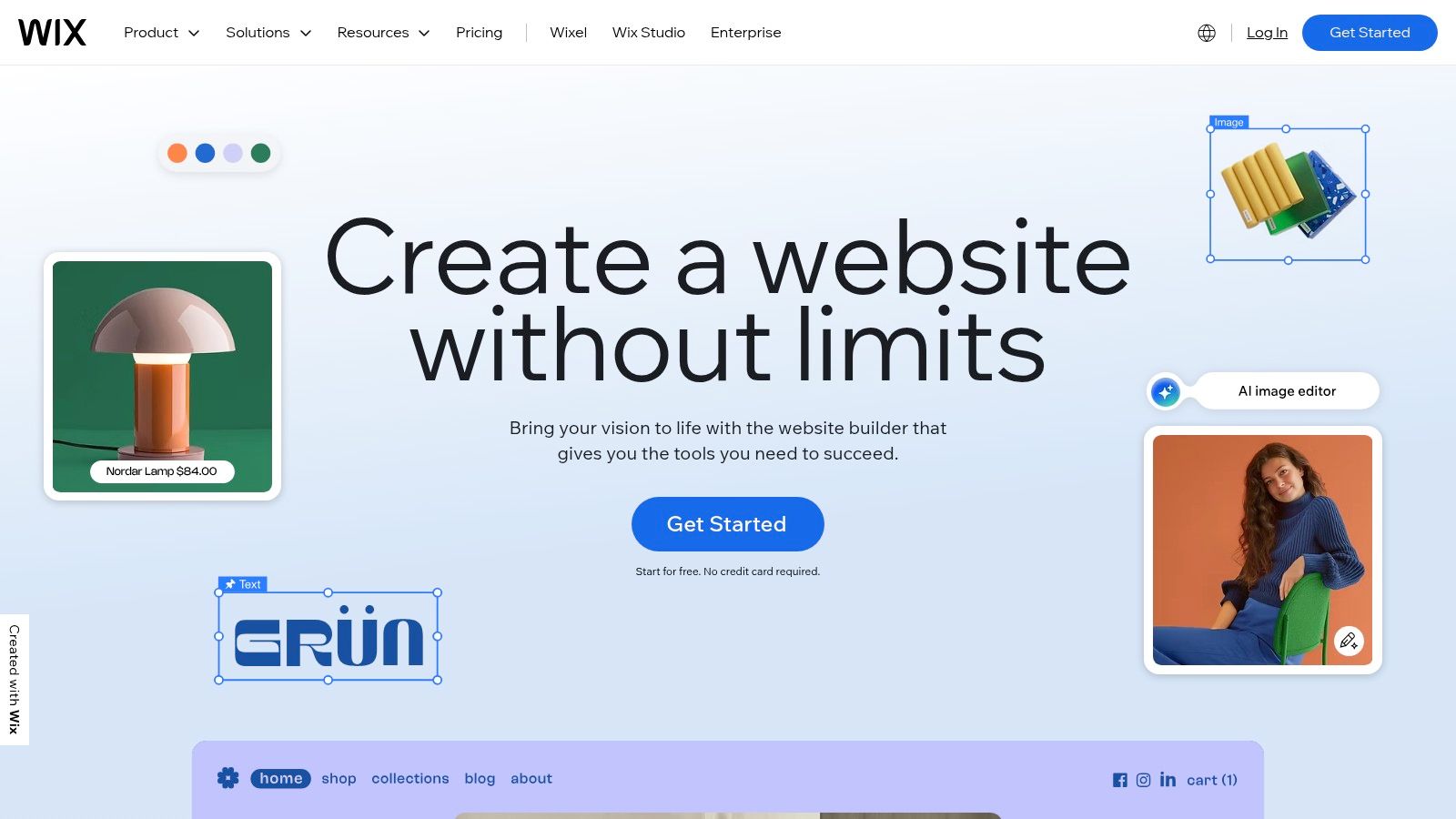
The platform is an all-in-one solution, bundling hosting, domain management, and robust marketing tools directly into the dashboard. With over 900 designer-made templates and an extensive App Market for added functionality like booking systems or advanced forms, Wix scales effortlessly from a simple portfolio to a complex e-commerce store with integrated payments. For agencies, the new Wix Studio provides a dedicated environment for managing multiple client sites with advanced CSS control and reusable assets.
Key Details & Pricing
- Best For: Beginners, small businesses, creatives, and agencies needing a powerful yet intuitive all-in-one platform.
- Pros: Extremely intuitive editor, massive template library, strong e-commerce and marketing features, and a viable free plan for testing.
- Cons: Once a template is chosen, you cannot switch to a new one without rebuilding. Add-ons and higher-tier plans can become costly.
- Pricing: A free plan is available with Wix branding. Paid plans start at $17/month (Light) and go up to $159/month for business VIP e-commerce plans.
Website: https://www.wix.com
2. Squarespace
Squarespace stands out among the best drag and drop website builders for its unwavering focus on polished, design-forward aesthetics. Its editor uses a section-based, structured drag-and-drop system, which ensures a clean, professional look across all devices while still offering significant customization. This approach is ideal for creatives, service-based businesses, and portfolios where brand presentation is paramount. New AI-powered tools, like Squarespace Blueprint, help jump-start the design process by generating unique layouts based on user prompts.
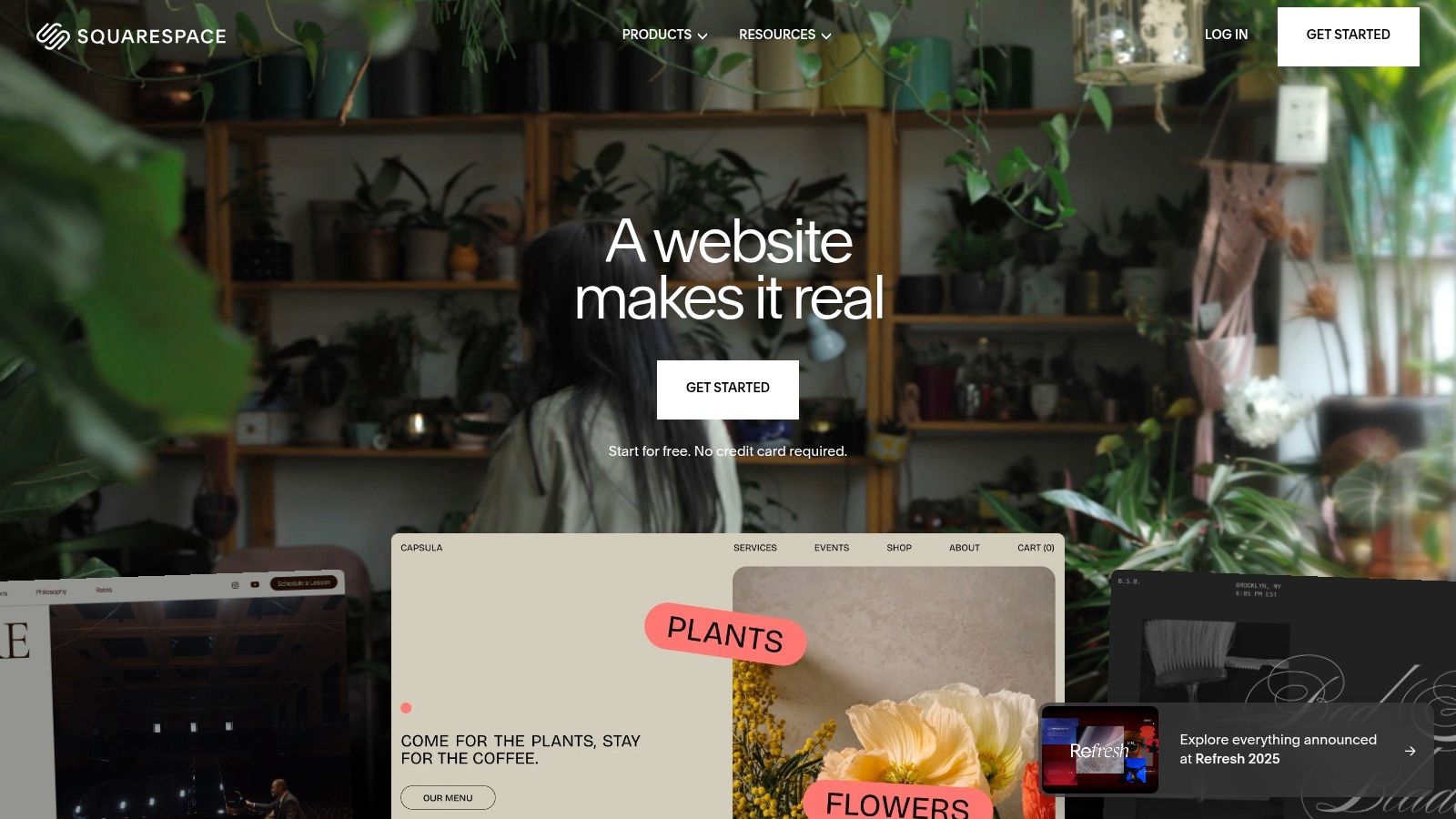
The platform is a true all-in-one solution, integrating powerful tools for blogging, scheduling, email marketing, and e-commerce directly into its core offering. This built-in functionality reduces the need for third-party plugins, creating a seamless and consistent user experience from the backend to the live site. All annual plans also include a free domain for the first year, simplifying the setup process for new users. Whether you want to build a simple marketing site or a more complex landing page, you can learn more about creating a Squarespace landing page to see its capabilities in action.
Key Details & Pricing
- Best For: Creatives, photographers, restaurants, and small businesses who prioritize sophisticated design and an all-in-one toolset.
- Pros: Award-winning, highly polished templates, a consistent and intuitive user experience, and a strong integrated feature set (scheduling, email, commerce).
- Cons: No permanent free plan is available for long-term use. The structured editor offers less creative freedom than a true free-form builder.
- Pricing: Plans start at $16/month (Personal) and go up to $49/month for the Commerce Advanced plan, with discounts for annual billing.
Website: https://www.squarespace.com
3. Webflow
Webflow bridges the gap between traditional drag and drop website builders and full-stack development, offering unparalleled design control without forcing users to write code. It provides a visual canvas where designers can manipulate CSS properties like flexbox and grid directly, giving them pixel-perfect authority over every element. This approach generates clean, semantic code, which results in highly performant and professional websites that are a favorite among designers and agencies.
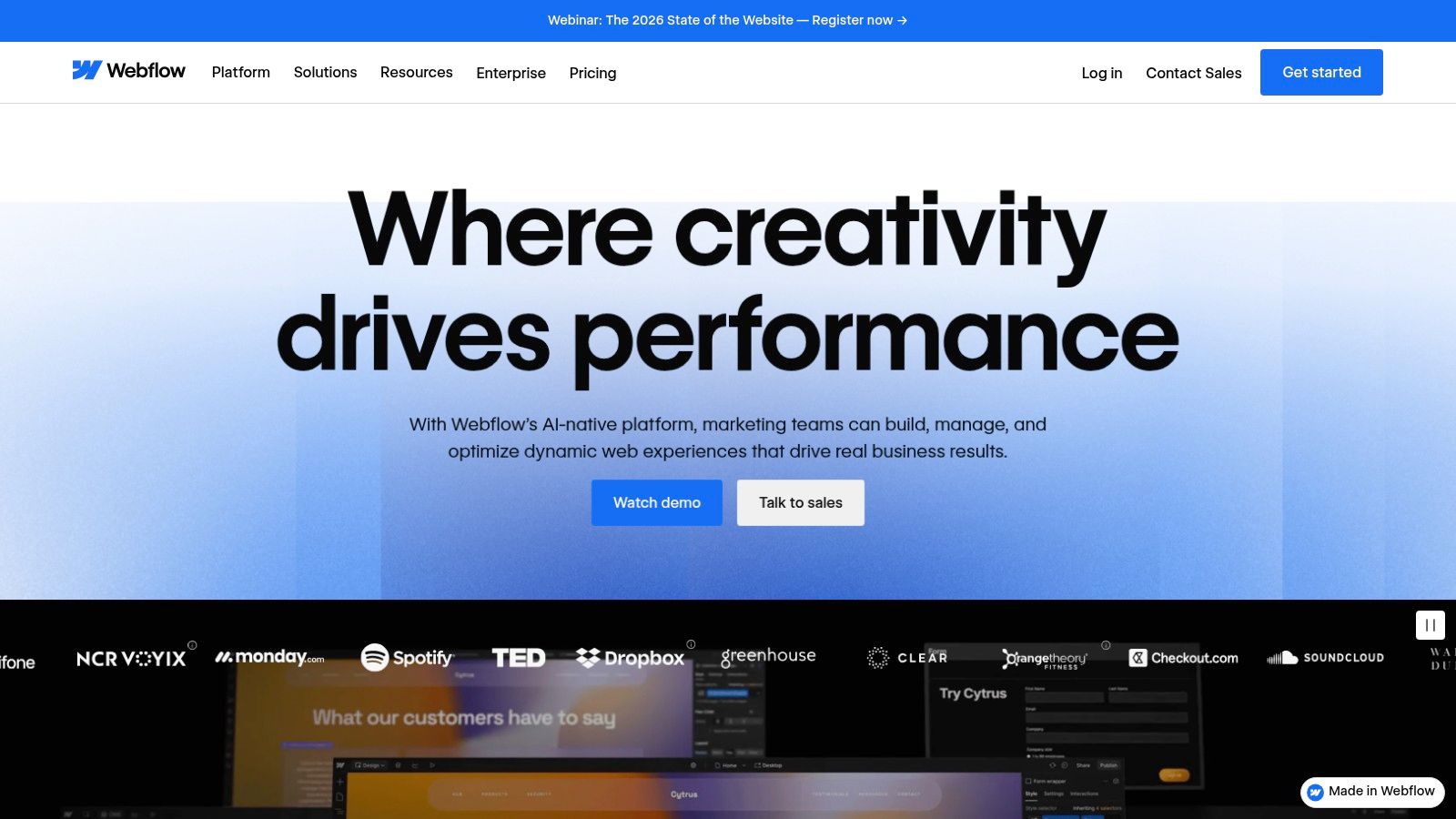
Beyond static pages, Webflow shines with its powerful, integrated CMS for managing dynamic content like blogs, portfolios, and team member directories. The platform's hosting is built for speed and reliability, and its logic and membership features allow for creating sophisticated, interactive user experiences. For those looking to build a professional site with custom design, the platform's robust capabilities are a major draw; you can see some impressive Webflow portfolio examples that showcase this flexibility.
Key Details & Pricing
- Best For: Professional designers, agencies, and businesses that need a high-performance, custom-designed website with a powerful CMS.
- Pros: Total design freedom with visual CSS controls, clean code output, exceptional site performance, and a robust CMS.
- Cons: Has a significant learning curve compared to simpler builders. The pricing structure can be complex, with separate plans for workspaces and site hosting.
- Pricing: A free plan is available to build and learn. Paid site plans start at $14/month (Basic) and CMS plans start at $23/month.
Website: https://webflow.com
4. Shopify
Shopify earns its spot among the best drag and drop website builders by being the undisputed leader in e-commerce. While it's a commerce-first platform, its Online Store 2.0 editor offers an intuitive, section-based drag-and-drop experience. This allows merchants to easily customize their storefronts, from the homepage to product pages, without touching a line of code. The focus is less on pixel-perfect freedom and more on creating high-converting, mobile-responsive online stores quickly.

The platform is an end-to-end commerce solution, handling everything from inventory management and secure payments with Shopify Payments to shipping and multichannel sales (e.g., social media, POS). Its true power lies in the vast App Store, which provides endless functionality for marketing, customer service, and store management. For those weighing their options in the e-commerce space, a detailed comparison of Shopify and WooCommerce can offer crucial insights. The platform’s scalability and dedicated e-commerce tools make it a go-to for serious merchants who need to build and grow a robust sales engine, supported by powerful e-commerce landing pages.
Key Details & Pricing
- Best For: Small to enterprise-level merchants who need a powerful, scalable, and dedicated e-commerce platform with integrated tools.
- Pros: Deep e-commerce tooling and a secure, fast checkout experience. It also has a massive app ecosystem and reliable 24/7 support.
- Cons: Using third-party payment gateways incurs extra transaction fees. The total cost can increase significantly with paid apps.
- Pricing: Plans start at $29/month (Basic) after a free trial and scale up to $2,300/month for the enterprise-grade Shopify Plus plan.
Website: https://www.shopify.com
5. WordPress.com
WordPress.com brings the power of the world's most popular CMS into a streamlined, hosted environment, making it a strong contender among drag and drop website builders. It utilizes the Gutenberg block editor, which allows users to visually construct pages by arranging and customizing content blocks for text, images, and more complex layouts. This approach offers a structured yet flexible way to design a site without touching code. For accelerated creation, the platform now offers an AI site builder on premium plans, capable of generating initial site layouts and content.
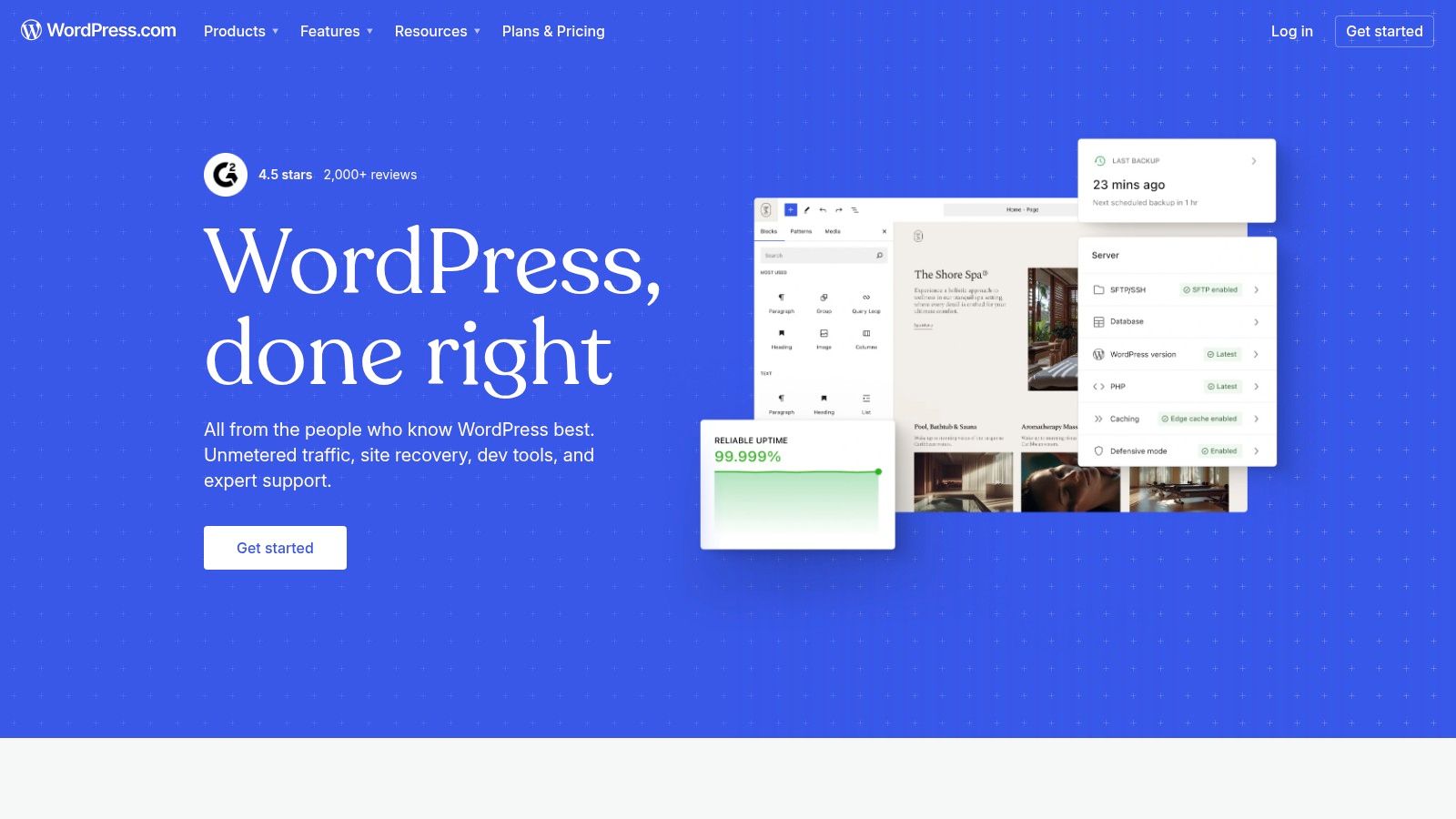
While the lower-tier plans are more limited, the true potential of WordPress.com is unlocked with its Business and Commerce plans. These tiers grant access to the vast ecosystem of over 50,000 plugins, enabling unparalleled extensibility for e-commerce, SEO, and custom functionality. This scalability makes it an excellent choice for businesses that anticipate future growth and need a platform that can evolve with them, supported by a massive community and extensive documentation.
Key Details & Pricing
- Best For: Bloggers, content creators, and businesses planning to scale who want the power of WordPress without managing their own hosting.
- Pros: Extremely extensible with plugins on higher-tier plans, a massive theme and support ecosystem, and strong content management features.
- Cons: Key features like plugins and advanced customization are locked behind more expensive plans. The editor can have a steeper learning curve than pure drag-and-drop builders.
- Pricing: A limited free plan is available. Paid plans start at $4/month (billed annually) for Personal, with Business plans required for plugins starting at $25/month.
Website: https://wordpress.com
6. Elementor
Elementor carves out a unique niche as a powerful drag and drop website builder that operates as a plugin within the self-hosted WordPress ecosystem. Instead of being an all-in-one platform, it transforms the standard WordPress editor into a dynamic, visual design canvas. This gives users the flexibility of WordPress's open-source power combined with an intuitive, live front-end editing experience, allowing for real-time changes without any coding knowledge.
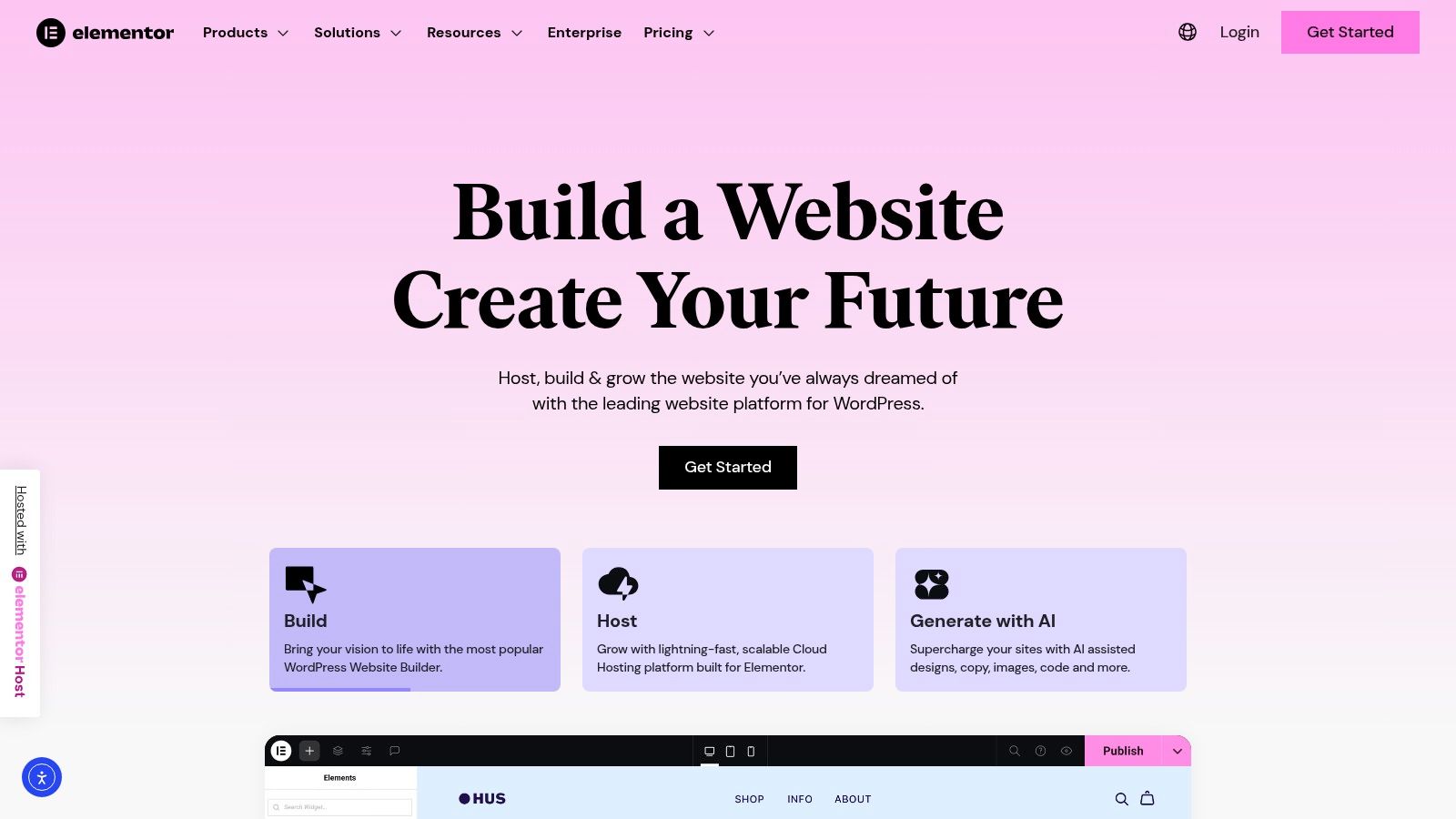
Its true strength lies in its Theme Builder, which enables the creation of custom headers, footers, and page templates from scratch, freeing users from the constraints of their chosen theme. The Pro version unlocks a suite of advanced widgets, including a powerful form builder, a popup creator, and a WooCommerce builder for designing custom product and shop pages. With a massive third-party ecosystem of add-ons and templates, the design possibilities are nearly limitless, making it one of the most versatile builders available.
Key Details & Pricing
- Best For: WordPress users, developers, and designers who want complete design control over their site without leaving the WordPress dashboard.
- Pros: Unmatched design flexibility within WordPress, extensive widget library, huge third-party ecosystem, and a capable free version.
- Cons: Requires separate WordPress hosting and a domain. Website performance is highly dependent on the quality of your hosting and theme.
- Pricing: A free core plugin is available. Paid plans for Elementor Pro start at $59/year for one website and go up to $399/year for agency plans.
Website: https://elementor.com
7. Square Online (Weebly by Square)
Square Online, powered by Weebly's technology, carves out its niche as one of the best drag and drop website builders for businesses that need seamless omnichannel sales. It’s designed from the ground up to integrate flawlessly with the Square ecosystem, including its renowned POS systems and payment processing. This makes it the go-to choice for restaurants, retailers, and service providers who need inventory, orders, and customer data to sync perfectly between their physical and online stores. The platform simplifies launching an e-commerce site, with built-in tools for scheduling appointments, managing online orders for pickup or delivery, and selling across social media channels.
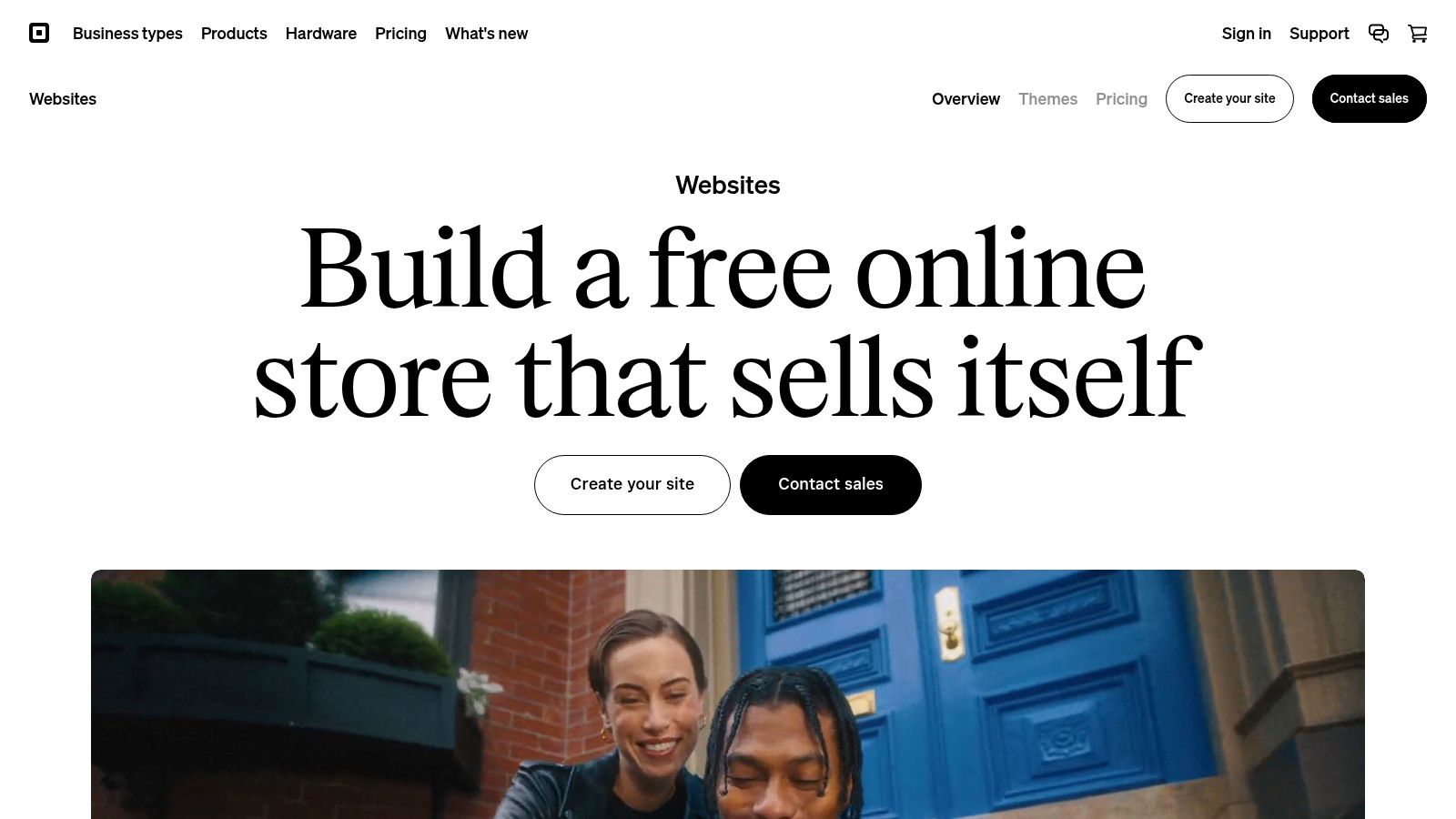
While its design customization isn't as granular as some competitors, its strength lies in its business-focused efficiency. You can get a functional, sales-ready website live in a very short time, with all the necessary e-commerce tools already in place. For businesses already using Square for in-person payments, expanding online is a natural and incredibly straightforward progression with this builder. It’s less about pixel-perfect design and more about powerful, integrated commerce.
Key Details & Pricing
- Best For: Retail stores, restaurants, and service-based businesses already using or planning to use the Square POS and payment ecosystem.
- Pros: Unmatched integration with Square POS for unified inventory and sales, generous free plan for selling, and straightforward setup process.
- Cons: Design and customization depth lags behind market leaders. Advanced features and more payment options often require plan upgrades.
- Pricing: A robust free plan is available to sell unlimited products. Paid plans like Plus ($29/month) and Premium ($79/month) offer advanced features and lower transaction fees.
Website: https://squareup.com/online-store
8. GoDaddy Website Builder
GoDaddy Website Builder is engineered for speed and simplicity, making it one of the best drag and drop website builders for small businesses needing to establish an online presence quickly. Its standout feature is the AI-powered setup tool, GoDaddy Airo, which generates a nearly complete website with images and text in minutes. This all-in-one approach bundles domain registration, hosting, an SSL certificate, and marketing tools like email campaigns and a social media content creator into a single, manageable dashboard.
While it doesn't offer the pixel-perfect control of competitors, its section-based editor is incredibly straightforward, ideal for service-based businesses, local shops, or simple portfolios. The platform excels at integrating essential business functions without overwhelming the user. You can add appointment booking, a basic online store, or a simple blog with just a few clicks. The inclusion of 24/7 phone and chat support provides a valuable safety net for those less comfortable with technology, ensuring help is always available.
Key Details & Pricing
- Best For: Small business owners and entrepreneurs who prioritize speed of launch and an all-in-one solution with strong support.
- Pros: Extremely fast setup with AI, integrates seamlessly with GoDaddy domains, and includes robust marketing tools and 24/7 support.
- Cons: Limited design flexibility and customization compared to more advanced builders. Renewal pricing can be significantly higher than introductory offers.
- Pricing: Plans start with a free trial. Paid plans begin at $10.99/month (Basic) and range up to $20.99/month for the Commerce plan.
Website: https://www.godaddy.com/website-builder
9. Hostinger Website Builder
Hostinger Website Builder (formerly Zyro) carves out its space among the best drag and drop website builders by offering an exceptional value proposition. It bundles an intuitive, grid-based editor with powerful hosting, making it a go-to for users on a budget who don't want to compromise on performance. Its suite of AI tools is a key differentiator, allowing users to generate text, create logos, and even predict user behavior with an AI Heatmap, streamlining the design process significantly.
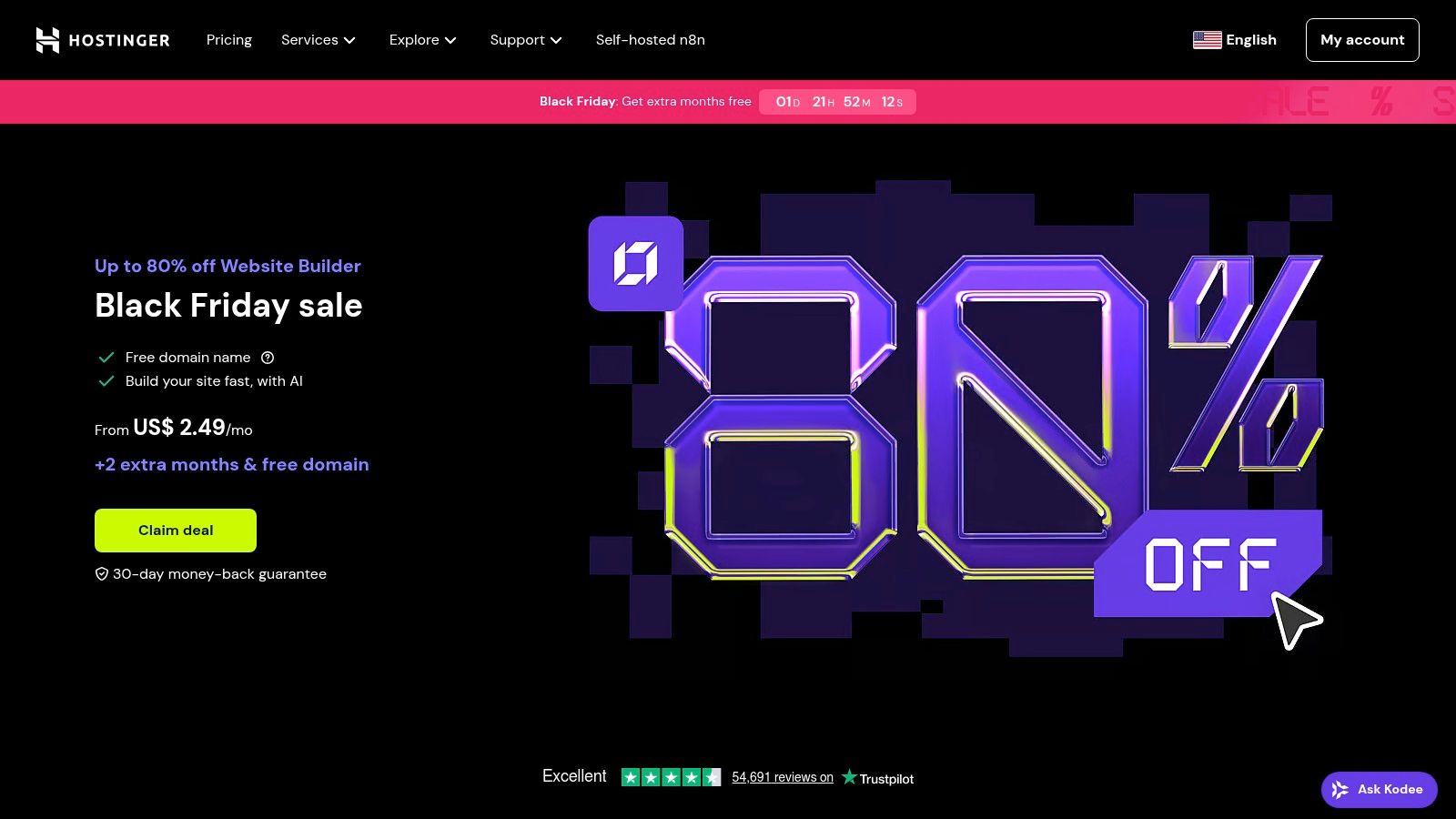
The platform is designed for speed and simplicity, both in site performance and user experience. While it may not offer the pixel-perfect freedom of some competitors, its structured approach ensures all sites are fully responsive and look professional with minimal effort. E-commerce capabilities are integrated directly, boasting 0% platform transaction fees on all plans. To delve deeper into Hostinger's overall services and hosting packages that often complement their website builder, consult a comprehensive Hostinger review. This makes it a compelling, cost-effective solution for personal sites, portfolios, and small online stores.
Key Details & Pricing
- Best For: Individuals, entrepreneurs, and small businesses seeking an affordable, all-in-one solution with strong performance and helpful AI tools.
- Pros: Extremely competitive introductory pricing, robust AI features for content creation, and includes high-quality hosting with a free domain for the first year.
- Cons: Renewal prices increase significantly after the initial term. The editor has fewer third-party integrations and advanced customization options than larger platforms.
- Pricing: No free plan is available. The single Website Builder & Web Hosting plan starts at a very low introductory rate, typically around $2.99/month.
Website: https://www.hostinger.com/website-builder
10. Framer
Framer distinguishes itself as a design-forward platform for professionals who demand high-fidelity visuals and top-tier performance. Initially a prototyping tool, it has evolved into a powerful drag and drop website builder that allows designers to publish directly from their canvas, ensuring pixel-perfect translation from concept to live site. Its real-time visual editor is renowned for its responsiveness and advanced animation capabilities, giving users unparalleled control over interactions and effects.
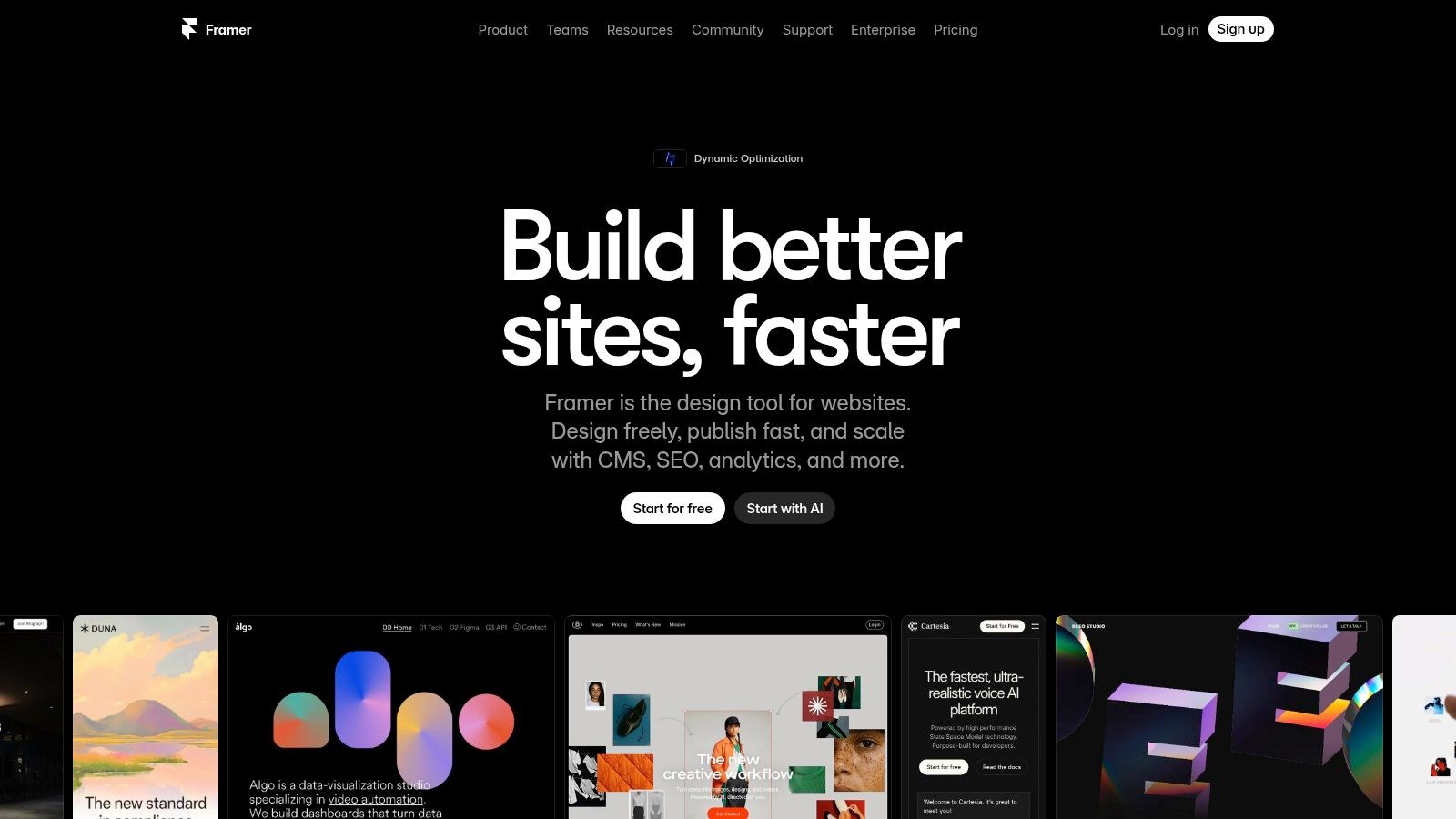
The platform is an integrated solution that bundles a powerful CMS, blazing-fast hosting on a global CDN, and built-in marketing tools. Features like localization, A/B testing, and collaboration are native to the environment, reducing the need for third-party plugins. This makes Framer ideal for startups and marketing teams that need to experiment and iterate quickly without sacrificing design quality or site speed, truly bridging the gap between design and production.
Key Details & Pricing
- Best For: Designers, startups, and marketing teams needing advanced visual control and built-in performance optimization tools.
- Pros: Unmatched design control and animation capabilities, high-performance hosting included, and built-in marketing tools reduce the need for add-ons.
- Cons: Per-editor fees can increase costs for larger teams, and usage-based pricing can become expensive as traffic scales.
- Pricing: A free plan is available for hobby projects. Paid plans start at $10/month per site (Mini) and go up based on features and traffic.
Website: https://www.framer.com
11. G2 – Website Builder Software category
While not a builder itself, G2’s dedicated category for website builder software is an indispensable research tool for making an informed decision. It aggregates thousands of verified, real-user reviews, offering an unbiased look into the day-to-day experience of using different platforms. This makes it one of the best resources for validating marketing claims against actual performance and customer satisfaction, a crucial step before committing to any of the best drag and drop website builders.
The platform’s strength lies in its powerful filtering and comparison tools. You can use the G2 Grid to visually compare top contenders based on user satisfaction and market presence, or create side-by-side comparisons of specific features, pricing models, and implementation details. Users can filter results by company size, industry, and required features, ensuring the feedback you see is relevant to your specific needs. This crowdsourced insight helps you uncover the true pros and cons of each builder.
Key Details & Pricing
- Best For: Marketers, entrepreneurs, and agencies conducting due diligence before selecting a website builder.
- Pros: Access to thousands of verified user reviews, powerful comparison grids, and granular filtering options for relevant feedback.
- Cons: Review volume and recency can vary significantly between popular and niche products. Sponsored placements can sometimes influence initial visibility.
- Pricing: Free to browse and use for research.
Website: https://www.g2.com/categories/website-builder
12. Capterra – Website Builder Software category
While not a builder itself, Capterra's dedicated website builder software category is an invaluable research hub for anyone comparing options. It serves as a comprehensive marketplace, aggregating dozens of tools in one place, which is why it’s a crucial resource for finding the best drag and drop website builders. Users can quickly filter platforms by features, pricing models, and business size, making it easy to narrow down a long list of potential vendors to a manageable few.
Capterra excels by providing at-a-glance comparisons, user reviews, and curated shortlists of top-performing products. This allows you to see how different builders stack up against each other based on real-world feedback. For businesses needing to make an informed decision, the platform’s detailed product pages and buyer guides offer a structured way to evaluate features, from e-commerce capabilities to SEO tools, before committing to a specific service.
Key Details & Pricing
- Best For: Businesses and individuals in the research phase who want to compare multiple website builders using verified user reviews and feature lists.
- Pros: Quick way to scan pricing tiers and features across many brands, curated "Shortlist" helps speed discovery, and extensive real user reviews provide social proof.
- Cons: Pricing snapshots can occasionally lag behind vendor changes, and sponsored placements may influence the ranking of tools in some lists.
- Pricing: Free to use for research. Pricing for individual website builders is listed on their respective pages.
Website: https://www.capterra.com/website-builder-software/
Top 12 Drag-and-Drop Website Builders Comparison
| Product | ✨ Core features | ★ UX / Quality | 💰 Price / Value | 👥 Target audience | 🏆 USP / Best for |
|---|---|---|---|---|---|
| Wix | Drag‑drop editor, 900+ templates, AI site gen, ecommerce | ★★★★ | 💰 Freemium → paid add‑ons | 👥 Individuals, SMBs, agencies | 🏆 Fast setup + large app ecosystem |
| Squarespace | Section editor, polished templates, ecommerce, AI Blueprint | ★★★★★ | 💰 Paid plans (no permanent free) | 👥 Creatives & small brands | 🏆 Design‑led branding & templates |
| Webflow | Visual CSS controls, CMS, clean code, performant hosting | ★★★★★ | 💰 Mid→high; complex tiers | 👥 Designers, agencies, content sites | 🏆 Pixel‑level design & clean output |
| Shopify | Online Store 2.0, integrated checkout, POS, large app store | ★★★★★ | 💰 Mid→high; app fees can add up | 👥 Merchants & multichannel sellers | 🏆 Best‑in‑class ecommerce stack |
| WordPress.com | Block editor, themes, plugins on Business+, AI site builder | ★★★★ | 💰 Free→paid tiers; plugins on higher plans | 👥 Bloggers, SMBs needing extensibility | 🏆 Extensible ecosystem & community |
| Elementor | Visual WP Theme/ WooCommerce builder, widgets, popups | ★★★★ | 💰 Free + Pro plugin; hosting separate | 👥 WordPress users & designers | 🏆 Powerful visual control inside WP |
| Square Online (Weebly) | Square POS/payment integration, ecommerce, pickup/delivery | ★★★ | 💰 Free plan; transaction fees apply | 👥 Retailers, restaurants, local sellers | 🏆 Tight POS ↔ online inventory sync |
| GoDaddy Website Builder | AI setup, hosting, SSL, marketing tools, 24/7 support | ★★★ | 💰 Low entry price; renewals can rise | 👥 Small businesses needing quick launch | 🏆 Fast all‑in‑one launch & phone support |
| Hostinger Website Builder | AI text/image tools, responsive templates, hosting included | ★★★ | 💰 Very low intro pricing; renewals | 👥 Budget SMBs & personal sites | 🏆 Value bundle: hosting + AI tools |
| Framer | Design‑centric editor, CMS, staging, analytics, A/B testing | ★★★★ | 💰 Usage‑based; per‑editor fees | 👥 Designers, startups & growth teams | 🏆 Design‑first with built‑in marketing |
| G2 – Website Builder category | Crowdsourced reviews, grids, filters, vendor links | ★★★★ | 💰 Free to use | 👥 Buyers researching website builders | 🏆 Real‑user feedback & side‑by‑side comparisons |
| Capterra – Website Builder category | Category pages, pricing snapshots, buyer guides, reviews | ★★★★ | 💰 Free to use | 👥 SMB buyers & researchers | 🏆 Quick pricing snapshots & buyer guides |
Choosing Your Next Step
Navigating the crowded market of the best drag-and-drop website builders can feel overwhelming, but the journey to finding the perfect platform is a strategic one, not a game of chance. Throughout this guide, we've dissected the top contenders, moving beyond surface-level features to reveal the core strengths and practical limitations of each. We've seen how Wix provides unparalleled ease of use for beginners, while Squarespace offers a curated, design-first experience for creative professionals. For those with serious e-commerce ambitions, Shopify stands as the undisputed champion, offering a robust, scalable ecosystem.
The key takeaway is that the "best" builder is entirely subjective and depends on your specific goals. A SaaS startup might gravitate towards the advanced design control of Webflow or Framer to build a unique marketing site, whereas a local business may find the all-in-one simplicity of the GoDaddy Website Builder or Hostinger perfectly sufficient. Meanwhile, entrepreneurs already invested in the WordPress ecosystem will find a powerful ally in Elementor, unlocking visual design capabilities without sacrificing the flexibility of the world's most popular CMS.
How to Make Your Final Decision
To avoid buyer's remorse, your selection process should be a hands-on investigation. Before you commit your time and resources, consider these final implementation steps:
- Test the Editor's Flow: Sign up for free trials or explore free plans for your top two or three choices. Spend at least an hour in each editor. Does the interface feel intuitive to you? Can you easily find the tools you need to build a basic landing page? This "feel" is a critical, often overlooked factor.
- Evaluate a Specific Template: Don't just browse the template library. Choose one that closely matches your vision and begin customizing it. This will quickly reveal the platform's rigidity or flexibility. Can you easily change fonts, colors, and layouts, or are you fighting the system?
- Check the App Marketplace: Your website will need to grow. Investigate the platform's app store or integration capabilities. Does it connect seamlessly with your email marketing service, CRM, or analytics tools? A weak integration ecosystem can become a major roadblock down the line.
- Review Your Budget Holistically: Look beyond the introductory price. Factor in the long-term costs, including transaction fees for e-commerce, the price of premium plugins or apps, and the cost of scaling to a higher-tier plan as your traffic grows.
Ultimately, choosing from the best drag-and-drop website builders is about selecting a long-term partner for your digital presence. By prioritizing your unique project needs, from design freedom to e-commerce power, and conducting thorough hands-on testing, you can confidently build on a foundation that not only meets your current requirements but also supports your future growth.
Once your new website is live, understanding its performance is crucial for growth. Pages.Report automates website audits by tracking key metrics and sending you simple, actionable reports directly to your inbox. Ensure your drag-and-drop creation is performing at its best by signing up for free at Pages.Report today.
